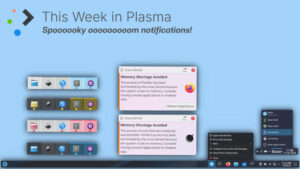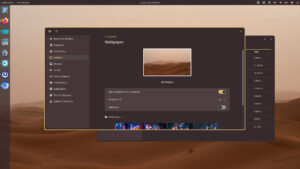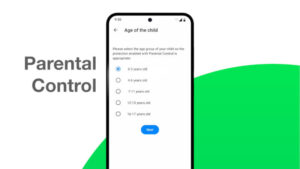The results of our “One Size Fits All” poll on phone and PC interfaces are in. Once again, we find that our thinking doesn’t match the majority.
Microsoft got themselves in a heck of a mess when they insisted their users should happily adopt their phone interface on their desktops. This didn’t work out well, with Windows PC users pretty much refusing to upgrade to Windows 8. Since then, Microsoft has backed down somewhat with version 8.1, but it’s too soon to tell how that’s going to work out for them.
| [yop_poll id=”29″] |
Apple and Google have chosen thus far to keep desktop and mobile not only on separate interfaces, but on separate platforms as well. Apple, of course, uses iOS for the iPhone and OS X for their line of Macintosh computers. Google has Android for mobile devices and Chrome OS for laptops. In both cases, the interface and branding are completely different for mobile and traditional devices.
Here in Linuxland, Ubuntu has decided to take a different tack. In this case, as we understand it, the interface on phones will look and feel a lot like their default Trinity desktop, but with changes made to allow for the smaller screen size. With both phone and desktop having a similar look and feel, users should be able to move back and forth between devices more easily.
After we made up our mind on our preference, we asked you what you thought with yet another of our unscientific polls, which we posted on October 10th. “Would you like your smartphone, tablet and PC interface to be the same?” we asked. We offered four choices: “Yes, exactly the same;” “Similar but not exact;” “No” and “Don’t know.”
| [yop_poll id=”28″] |
At FOSS Force, we mostly agreed that we favored the alike-but-different approach, for a variety of reasons that we’ll happily comment upon if you ask. You disagreed. In our poll, which we deactivated just this morning, only 37% of you agreed with us.
The overwhelming majority voted “no,” indicating that you’d prefer phone and desktop to have completely separate interfaces. Only 8% of the voters liked the Microsoft option of an interface for phone and PC that exactly matched. 1% of you were undecided.
So that’s it then. A phone should be a phone and a desktop should be a desktop and never the twain shall meet.








Recognizing that hardware, especially display size, and where we use that hardware — on a desk, in a lap or in our hand –hasa lot to do with design choices seems obvious. MS forgot that when the combined Metro (works on phones) with the Win7 panel approach for things that are not phones.
We Linux folks need to remember, as well, that avoiding a panel-based interface is not tantamount to forcing phone interfaces down the throats of desktop users.
I don’t expect to see the PC market to exist much longer, at least not as we known it. I see Android edging out Windows, Linux “desktop” installs, and even Chromebooks. I expect OSX and iOS will start to show more signs of merging into a unified interface and Android taking over the majority of the tablet-esque general purpose computing devices.
I think you’re wrong about the PC, Andrew. What we’re seeing is a major adjustment. Phones and, especially, tablets have offered an alternative for those folks who never liked PCs and laptops to begin with. People who just want to shop, play on Facebook, watch movies and cat videos and the like. Tablets are also very useful for some business uses. However, a great many of us will continue to need full fledged tied to a keyboard computers to get our work done and the business need for traditional desktops and workstations isn’t going to go away any time soon. This isn’t to say that the traditional desktop isn’t going to continue to evolve, however.
@Christine you very well could be right. I’m thinking along the lines of the hybrid multi-functional Android devices like we see with the ASUS Transformer, HP Slatebook, the Slate 21 etc. There will always be cases where a traditional PC like machine is going to be the best fit, but I think it’s going to shrink significantly.
I know that today with all of the apps I have available, if my traditional laptop were to break I could easily do everything that I need to do with my Nexus 7. With the multitude of apps available, I can do everything. Things like checking email, managing my personal VM farm with QuadProx, working on whatever code I need to work on in that farm with JuiceSSH, I can even watch my DVR remotely.
I think we are there. I think next year is going to be pretty exciting for consumers.
@Andrew I think you’re right. We have choices that were unimaginable just five years ago–and it’s exciting. But I think the desktop will remain a workhorse for many years to come. 🙂
Although the mobile marketplace is teeming with devices that can do-it-all for any type of task, I also don’t see the use of laptops and PC’s diminisghin anytime soon, maybe in the next 10 to 15 yearsw….but for the here and now, I think both of them are in it for the long haul, businesses might be running a BYOD program, but servers, workstations that access viable data remotely, and conference rooms are going to need machines that can handle and meet their needs in a corporate sense, and even the highest-end tablet or smartphone cannot “hang” with a laptop or PC that’s built to handle massive computing workloads and multi-tasks. But the PC market is evolving and changing. There was a time when most home users just wanted the basics when it came to home computing, now the average consumer goes shopping for the multi-media, HD graphics, video-audio-connectivity-multiple-input-massive processing power, gaming-instensive, monster of a machine….and becuase of the boom in tablets and mobile, the prices for computers like that have dropped, making them more accessible,…and once again…while using a tablet is fun, and can help in productivity, and easier to use, it will never match up to machiens that are designed to be worked hard. And while mobile devices are truly a benefit and a big plus for most people, they too have their drawbacks and are susceptible to damage (touch-screen, water,cracked screen, dropped form heights..etc). SO it really all must boil down to a matter of personal preference,and I’m a “Neanderthal” still using a GATEWAY computer with a dual core Pentium in it! LoL! And even though I’m certain there are tablets out there that can match or even outperform this clunker….I just prefer hardware I can “get to” and swap out if need be….but to each their own I guess!
Sorry for the lengthy post, but this is my hot-button subject going on 3 years now.
We have only to look to the automobile, or rather the transportation industry, to read the tea leaves. Aircraft didn’t obviate ships anymore than they did trains. Cars didn’t entirely obsolete trams, even if the latter only hold on in Europe because of union blackmail of entire nations to perpetuate their Luddite business models.
And this same debate even began in the computer market as laptops began first cutting into, and then out-pacing tower sales. And the makers were scrambling back then to find that one, golden device that would satisfy all the buyers. Even recently, Dell sold, and then discontinued, a 20-inch screen ‘laptop’. Everyone in the industry completely misread the entire ‘netbook’ phase, including those who invented the whole thing.
The silver bullet is a red-herring.
And we’ve seen the same thing in the auto industry for decades. Each manufacturer is always trying to best its competitors with a ‘world car’ that can be sold in large numbers in any market in the world with minimal variation. It’s never happened. Laws vary. Tastes vary. Needs vary.
One size does NOT fit all, no matter what they tell you.
And it isn’t just Microsoft (re)learning this lesson the hard way. Nor is this new to Metro. People didn’t like the menu/UI in 7, Vista, or the native menu in XP, either. Hence ‘Classic Shell’. If you Windows users haven’t tried it, you should.
Gnome, Ubuntu, even KDE to some extent, are being reminded that their base is really in keyboard-centric computing, whether you call that a desktop, laptop, hybrid, convertible, or whatever. It has a keyboard for a reason, and if you neglect that keyboard because you’re too lazy or stingy to maintain, or assume your customers are too stupid to learn, two different UIs, then you’re going to feel the wrath of your customers, even if they don’t really pay for the product up front. And more especially, if, like Canonical, you’ve been deliberately leading those customers down a path.
To make matters worse, even Apple is now getting sucked into this madness, albeit to a lesser degree, and all the software makers are actually resorting to insulting their own users as knuckle-dragging troglodytes too dim to recognize what magic has been entrusted to their slobber-soaked hands.
That’s going to end badly for the entire industry, an industry now wide open to any vendor willing, even eager to flatter those now wounded users, and give them exactly what they want.
BUT IT’S NOT JUST THE UI!
Laptop makers in particular, the one sector of the computer market with the potential to stand strong, years ago began to buckle under the same uncertainty, and took a wrong turn. How? Look at all the latest laptops. Which ones have a real keyboard? Not those chicklets things, but real keys. Which ones have dedicated navigation keys instead of double-mapping them? (PgUp, PgDn, Home, End, etc.) How many are backlit? (Only the single best feature ever!)
None. Not one. I kid you not. One has backlighting, but also flat-topped, gap-spaced keys. Another has sculpted keys, but double-mapped, or micro-sd-card-sized cursor-keys. No manufacturer has had the golden combination of all the right keyboard features for years now.
I’ve actually taken to upgrading 5-year-old HP dv3510nr laptops with better processors, SSDs (in RAID0 no less), and all the RAM they can swallow, rather than waste any more money on ANY of the laptops produced since. These ‘old’ laptops outrun all but the most expensive of the newer models, and I now run my little business on 3 of these ‘antiques’, with lots of spare parts, extra power adapters and batteries. I’m set, and I’m happy.
What’s more, I still use Ubuntu 10.04 on two of them, because it’s still quite keyboard friendly. And I experiment with other distros and desktops on the third unit, just in case a viable path to the future ever does open up. So far, Mate on top of Ubuntu 13.10 is looking best, but Mint/Mate is no slouch either.
But will any manufacturer ever give me a proper keyboard again? Not as long as they’re convinced that I really want a 4-inch wide touch-pad, or, worse, to touch my screen.